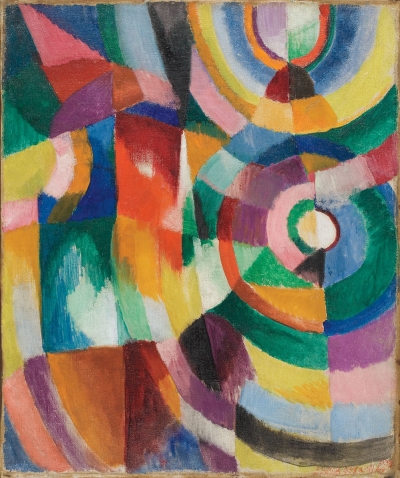Electric Prisms, 1913, Oil on canvas, 22 by 18 inches
Gift of Mr. Theodore Racoosin, 1956.16
Sonia Delaunay-Terk was among the most important artists of the early 20th century. Along with contemporaries in Europe such as Wassily Kandinsky and Frank Kupka, and her partner Robert Delaunay, Delaunay-Terk led the art world toward an exclusively nonrepresentational art. Her 1913 painting Electric Prisms exemplifies a key early example of this shift to abstraction.
Although Delaunay-Terk has received important scholarly attention in recent years, her status as a female artist slowed recognition of her remarkable contributions to modern art. Her gender, as well as her investigation of abstract form and color in materials beyond painting, such as collaged book covers, clothing, and domestic objects, disrupted narrow definitions of achievement in art. Delaunay-Terk’s ability to work across media, however, has provided an important point of reference in contemporary art history for the dismantling of hierarchies between craft and fine art, domestic and public spheres, and utilitarian and aesthetic objects. The artist’s long career exemplifies an expansive engagement with innovative ideas throughout the 20th century.
Electric Prisms captures the sparkling energy of French culture just before the devastating years of World War I. Delaunay-Terk was only 28 years old when she painted the work. Across the modestly sized canvas, the artist deploys a vibrant array of colors to construct geometric forms. Varying the intensity of her paint, Delaunay-Terk suggests light and shadow by combining areas of thinly applied color with layered brushwork and deep hues. The abrupt shifts of color between jewel-toned rectangles, arcs, and triangles creates a prismatic effect. Two vertical lines emerge from these chromatic juxtapositions to divide the composition into three segments. Concentric circles on the right side of the canvas draw the viewer’s eye and offer a briefly stabilizing form, yet Delaunay-Terk’s use of varied shapes and colors establishes the optical effects of radiant light as her primary theme. The title’s reference to electricity establishes artificial light—perhaps the street lamps of Paris—as the artist’s subject, and implies the still relatively new sensation of that technology in urban spaces at the start of the 20th century. Electric Prisms embodies a powerfully layered evocation of modernity. Delaunay-Terk’s dynamic visualization of a scientific wonder transforming daily life not only helped establish a new abstract vocabulary for painting, but also defined the start of a groundbreaking career.








We ask that those who engage in Wellesley magazine's online community act with honesty, integrity, and respect. (Remember the honor code, alums?) We reserve the right to remove comments by impersonators or comments that are not civil and relevant to the subject at hand. By posting here, you are permitting Wellesley magazine to edit and republish your comment in all media. Please remember that all posts are public.